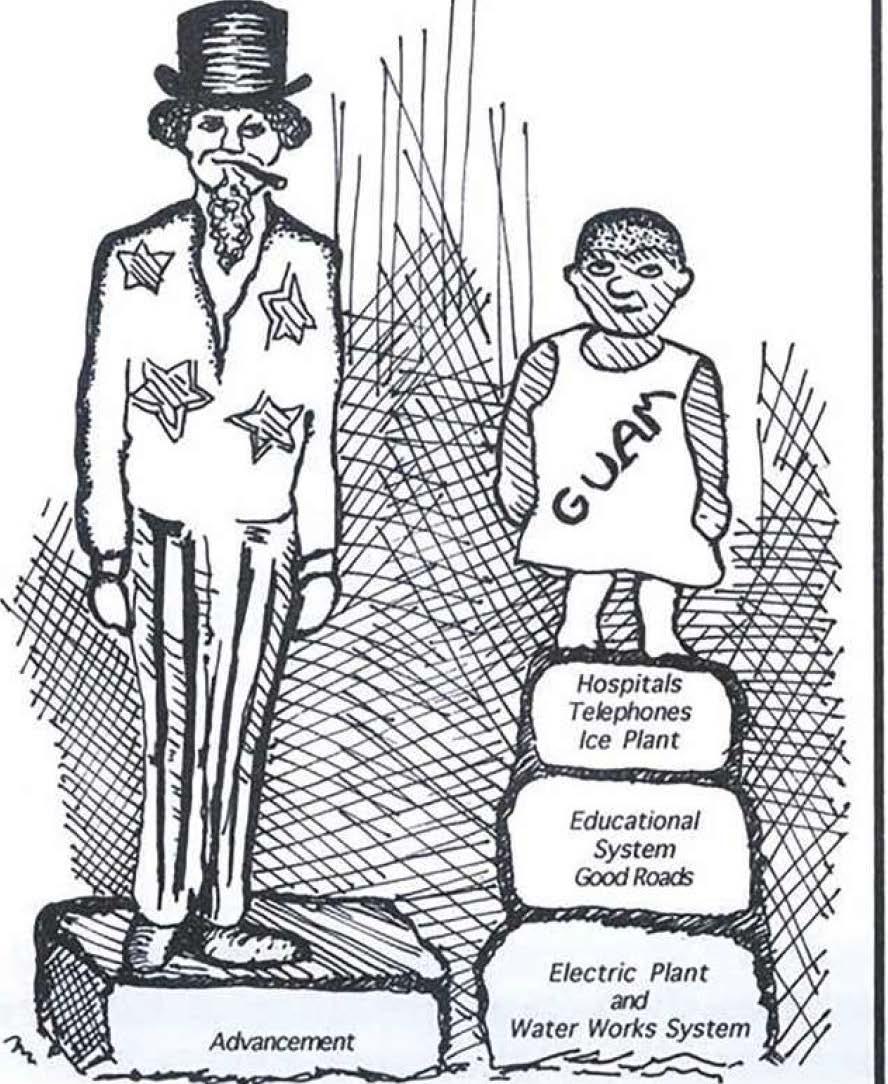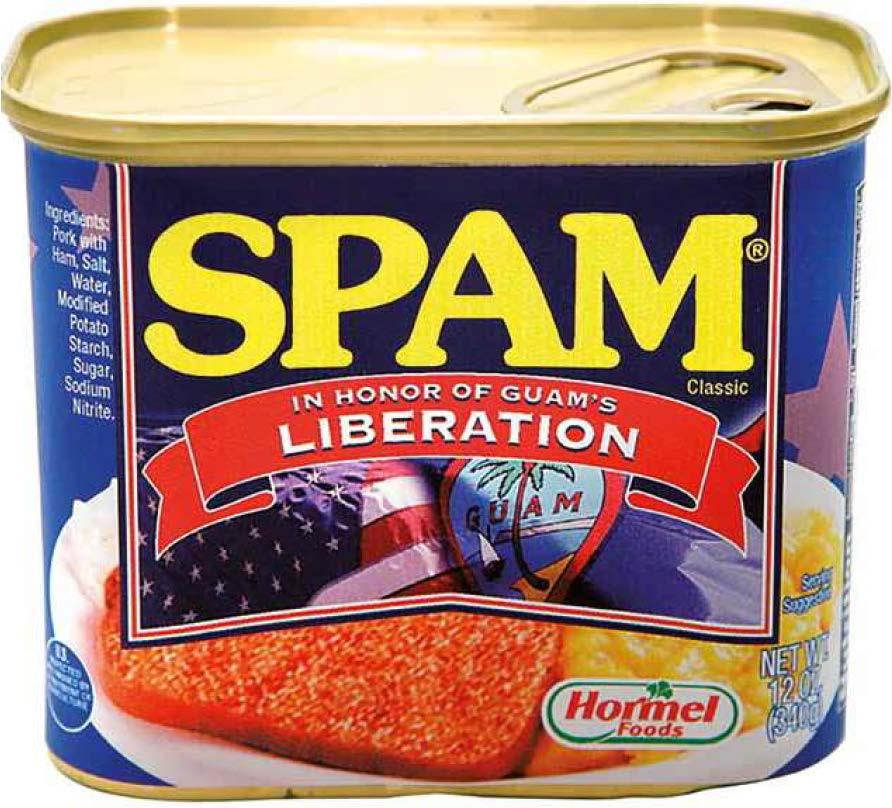




An exhibition of "Let's turn around the world" Official Program of the Fifth Centenary of the First Round the World

Museo Nacional de Antropolog1a
18/11/2021-06/03/2022
Ministerio de Cultura y Deperte and Acci6n Cultural Espanola
In association with:
Department of Chamorro Affaires
Museum of Guam
University of Guam
MicronesianArea Research Center
Guam Preservation Trust
And with support of:
Universitat Pompeu Fabra
Universidad Aut6noma de Madrid
Archive del Museo Naval
Museo Naval
Museo de America
Biblioteca Nacional de Espana
RealJardin Botanico
Anne Perez Hattori University of Guam
A quick Google Images search of Guam reveals an abundance of stereotypical Pacific Islands imagery. Sandy beaches, calm ocean waters, graceful palm trees, and clear blue skies dominate the online photo galleries. Yet Guam's reality can jar the expectations of those who expect to find a cliched island paradise. Indeed, as a professor at the University of Guam, I have often conversed with incoming faculty, often fresh from the United States mainland, who express shock and dismay at the state of our Island, surprised to see the multiple signs of Americanization, from the plethora of USassociated businesses like Kmart, McDonalds, and Macy's to English as the predominant language in households, shops, and government offices. At first glance, Guam appears to be a prosperous island with all the amenities affiliated with modern life: electricity, running water, paved roads, shopping
1 Laurenz Fejeran, then a University of Guam undergraduate and now teaching Guam History and US History at Okkodo High School, coined the phrase "Uncle S(p)am" in a paper written for my historiography class. He has generously permitted me to use "Uncle Spam" in my writing. St yu'us ma'ase, Renzi
malls, and fast-food restaurants. But this superficial show of modernity masks a deep and growing chasm of pain, loss, and conflict. Instead of idyllic scenes of native islanders fishing in the ocean or sailing in their proas, visitors encounter rush hour traffic jams and homeless panhandlers at the major intersections, as well as hospitals, schools, and dialysis centers filled beyond capacity. Instead of an island population that regularly eats tropical fish, fruits, and vegetables, they discover a population reliant upon Spam, corned beef, and other imports from the US. Indeed, the local newspapers confirm each and every day stories of an island struggling to cope with modernity.
Guam's catchiest slogan, Where America's Day Begins, in reference to the island's proximity to the International Dateline, itself hides a century's violence of US colonialism and militarism on Guam. It expresses an American presence backed by dollars and typically represented as exceedingly philanthropic yet perpetuating American power in the Pacific while marginalizing indigenous Chamorro land rights and cultural practices.
The tensions resulting from a massive US military presence on Guam escalate from time to time, as various of the world's nuclear powers threaten Guam while flexing their muscles towards America. A news headline on 11 March 2021, for example, stated, "Inda-Pacific Commander tells Congress: 'Guam is a target today. "' The article expressed US military desires to increase the island's missile defense capacities due to "emerging threats" in the region -in this particular instance, from China (Kaur, 2021a: 1)-.These statements were prompted in part by a Chinese propaganda video released by their Air Force in 2020 that showed a simulated bomber attack on Guam's US Air Force Base. But Guam-astarget came as no surprise to island residents.Just a few years earlier, North Korea had made similar provocations, threatening "an enveloping fire at the areas around Guam" with missiles that would take 14 minutes to reach the island (Domonoske, 2017: 1; Raymundo, 2017: 1).Yet the 2021 and 2017 threats against Guam by China and North Korea are but the latest in a series dating back to the beginning of the Cold War. Indeed, Australian scholar Gary Smith likened our region of the northwest Pacific to the USSR's "Iron Curtain," writing, "For the United States, control of the islands of Micronesia was the strategic equivalent to the Soviet Union's control over Eastern Europe" (Smith, 1991: 3). Guam figured mightily in this scenario as the US gobbled up vast tracts of island farmland in order to build its military bases, air strips, and harbors. For Guam, the Cold War has never been cold and continues to be as threatening as ever. Understanding how Guam came to be in this precarious position requires an introduction to the island's history under US rule.
In1898, USSecretaryofStateJohnHayreferred tothe Spanish-American War as the "Splendid Little War," reflecting the enormous gains gotten by the US at the cost of only minor casualties. Guam's history bookslikewiseportray this war and the island'sconsequent transfer of colonial power from Spain to the US as a joyful, even comical event given Spain's
inability to face offagainst the US military on the island (Rogers, 2011: 112; Carano and Sanchez, 1964: 219). Other sources, however, propose a more realistic view of this dramatic event. Given that the Chamorro people had for more than two centuries fallen under Spanish rule, an overnight shift of power would have been highly disturbing. An account written by Catholic priests Ildefonso Cabanillas and Cris6gono Ortin, who had lived for decades in the Marianas, reports that, "The entire populace became very alarmed and their great distress was very evident. Entire families, overwhelmed by fear and anguish, abandoned their homes and fled into the bush. A large number of devout families flocked to the church, fervently and tearfully beseeching God to put an end to this calamity" (Driver, 2000: 48).
For the Chamorro people, not only would their government shift to American hands, but their island chain would be split asunder. In their move to become a global power, the US opted to claim Guam alone, ignoring the other Mariana Islands, and opening the door for Spain to sell them to Germany, who less than two decades later would lose them to Japan as part of the spoils of World War I. The division of the Mariana Islands into two political bodies created tensions that climaxed during World War II when Guam and the Northern Marianas found itself on opposite sides of a war-nottheirs, Guam Chamorros remained steadfastly loyal to the US while Northern Marianas Chamorros understandably sided with their colonial master, Japan. The direct and indirect costs of those split alliances continue to divide the Chamorro people, more than 70 after the Second World War.
After defeating Spain in 1898, the United States would send the Navy to run the island, for Guam's true value to the US was its Apra Harbor, one of the region's best natural harbors, both wide and deep enough to handle incoming American ships. But US Navy officers were not trained to govern a new colony, and they established a dictatorial government in which the military commander had absolutepower.Chamorros soon protested this extreme form of rule, writing in a 1901 petition to the US Congress that "fewer permanent guarantees of liberty and property rights exist now than when under Spanish dominion. The governor of the island exercises supreme power in the executive, legislative,

and judicial branches of government, with absolutely no limitations to his actions" (Petition, 1). Congress, however, failed to even acknowledge the petition, much less address its concerns, and proceeded to ignore further petitions in 1917, 1925, 1929, 1933, 1936, 1947, 1949, and 1950 (Hattori, 1995: 5).
US Naval rule over Guam would continue well after the Second World War, as would the consistent dismissal of Chamorro aspirations to receive an ''.American" form of government on the island. The native people learned to co-exist peacefully with the small-sized military presence on the island which approximated 10% of the total population and who regarded the Chamorros as child-like and incapable of self-rule. The navy-published cartoon, More Like His Dad Every Day, demonstrates this infantilization well (YV.A.A., 1912).

Anticipating its entry into World War II, two months before Japanese forces invaded Guam, the US military relocated its white wives and children to the mainland. Left to fend for themselves were the Chamorro wives of American military personnel, some of whom were targeted for rapes and other atrocities (Merfalen, 2003; Howard, 1986). The US Navy government that had run the island since 1899 had pared down to a skeleton crew of some 500 men who specialized primarily in managing its communication systems. In fact, when theJapanese invasion force of more than 5,000 militia landed, a ragtag group of 247 Chamorros, accompanied by only a handful of US military men, fought in defense of Guam (Sanchez, 1988: 181; Underwood, 1994: 2). Organized as the Guam Insular Force Guard, this voluntary unit had received little training and was armed with few pieces of World War I era weaponry. Their extraordinary valor has been generally obfuscated by the deafening tale of American "liberation" heroics.
JapaneseoccupationofGuamduringWorldWarII forms such a central part of the Chamorro imagination that the entire historiography of the 20th century is shaped around it, with history books, as well as oral history accounts, typically dividing the 1900s into Pre-War, War, and Post-War eras. This outstretched coverage attests to the war's enormous impact as Chamorros faced a plethora of previously unimaginable threats and fears over 32 months of wartime occupation. Books about this era bear titles such as An Island in Agony (Palomo,1984) and A Tragedy ofGuam (Howard, 1986), speaking to the executions, beatings, rapes, and other extreme experiences of the war. The entire population experienced forced marches and internment camps in the final weeks of the war. Thus, for the Chamorro people of that era, the shared experience of World War II provides a universal narrative of trauma, fear, and suffering. It also provides a universal narrative of salvation, liberation from enemy occupation due to the heroism of the US Marine Corps.
While America's return to Guam in 1944 certainly andthankfullyendedaharrowingenemyoccupation, it also brought aboutunprecedented problems -not only the wartime devastation of land and property, but also

the postwar land takings by the US military-.Wartime bombardment destroyed roughly 80% of the island's homes and other structures, including almost all the capital of Hagatfia (Agafia) where half the population had previously resided (Leon, 1996: 109). Chamorro business leader, Anthony Leon Guerrero writes that "the American re-invasion of Guam caused more damage than any earthquake, typhoon, or other event in history [and] this time, even the land was ruined for farming" (Le6n,1996: 90).Destructionoftheislandwas, however, not limited to US military battles againstJapanese occupiers. Immediately after defeating Japan in theso-called"Battle forGuam," the USbegan using the island as a base for the remainder of the war.By 1946, the military had built 21 bases and stationed more than 200,000 personnel on the island.To accommodate this large influx, native lands were confiscated, including 75% of their farmlands, as well as fishing grounds adjacent to the new military bases (Sanchez, 1988: 272).
Without access to their farmlands and fishing grounds, Chamorros desperately sought new avenues to alleviate the rampant malnutrition faced in the immediate postwar period (Sanchez, 1988: 199; Rogers, 2011: 164). Malnutrition affected nearly the entire indigenous population by war's end, due in part to widespread confiscations of food to feed thousands of Japanesesoldiers (Underwood, 1994: 9).To this rescue came the victorious American forces whose military storage depots abundantly provided canned foods, so that the Chamorros, as scholar and war survivor Pedro Sanchez writes, "ate to their hearts' delight" and "hoarded cases and cans" of these rations in case the food supply was ever again threatened.Sanchez writes that "tons" of canned goods were given away, so much sothat Chamorro shelters "lookedlikemini-warehouses" (Sanchez,1988: 249).
Spam figured largely among the hoarded canned goods (Rogers, 2011: 185), and war commemorations onGuam invariably connect this particular brand of canned meat with freedom and loyalty to the US. The commercial advertisements below, produced for Guam's 60th anniversary of liberation from the war, illustrate an important motif in the post-war Guam story. As stated below by war survivor,Josephine Palomo, "we're very grateful, we're very thankful that our mother country came back for us. The soldiers were very, veryfriendly. Theydistributedallkindsofcandies, all kinds of canned goods.And I tell you SPAM was number one!" (Dickerson & Quinn).


"And ofamnc, MT'rr �'O')'RHleful, wt"'rt vny thanliful1h01011r mo1l1<rt111mt,yt<tm< bol.kfor HS.'17H .soldim u'ffl' 1,ny. i,ayfrimdly. 7"hty Jis1ribu1td allkindsoftattdlt.s ,J/l ltinds ofto,1,1<dgoodl. Ami I ull )'111, SPAJ\•ru,as 1111rnba011t'!"

In the immediate wartime scenario, educator Pedro Sanchez describes that while Chamorros were "stunned by the total destruction of their communities" and pained to lose their land, they were also "grateful to be alive and free under the American Flag" (Sanchez,1988: 254). Spam has since served as a powerful reminder of freedom from the war's physical and psychological brutalities, as well as a daily sign of American heroism and generosity. It functions as a metaphorfor USgenerosityandvalor,albeit atthecost of Chamorro land and bodies.
The theme of Chamorro gratitude to the US, evidenced in part by commemorative Spam cans and advertisements, becomes the powerful, ideological banner under which the rest of Guam's history is understood. In her powerful essay, Psyche under siege: Uncle Sam, look whatyou've done to us, Chamorro scholar Laura Torres Souder conveys, "The joys of 'liberation' were sweet. Chamorro survivors ofWorldWar II embraced all that was American with overwhelming gratitude and profound respect. Uncle Sam and his men were worshipped as heroes" (Sauder,1994: 193). Yet while "Uncle Sam is typically viewed as a great benefactor, a white-bearded Santa Claus whose generosity is unparalleled," Souderwrites, "We who have paid the price exacted from this costly relationship with Uncle Sam know better.... [F]or us, the war has not ended" (Ibid,1994: 195).
Stripped of their farmlands and pushed out of their villages to make way for the incoming US military, Chamorros were forced to survive under new and excruciating conditions. Lack of access to farmlands ranked foremost among these changes, and by 1950, only 23% of thepreviouslyagrarian population relied upon farming and fishing as their primary occupations. By 1960, this would fall even further to 8.8 percent (Santos-Bamba and Hattori, 2020: 292), and today, Guam imports nearly 90 percent of its food (Natividad and Kirk, 2010: 3). This hyper-reliance on imported, mainly processed foods has led directly to a dramatic upsurge in non-communicable diseases such as diabetes and cardiovascular ailments. One revealing statistic shows that while only 3% of Guam's deaths between 1910 and 1940 were attributed to diabetes, heart attack or stroke, by 2000,thatnumberwouldswellto 33% percent (Haddock, 2010: 214-219). Diabetes is now the fourth leading cause of death on Guam. Similarly, Rapadas (2007: 35) reports that "Indigenous Chamorus have the highest rates of diabetes, obesity, hypertension,
UncleS(p)am:The expensivecostsof US colonialism in Guam
and cancer on Guam when compared to other ethnic groups". Chamorros also comprise the largest percentage of Guam's homeless population with annual census counts from 2015 through 2018 revealing that Chamorros comprise the largest segment of the island's homeless population (GHC, 2018: 8). Prior to the Second World War, homelessness, landlessness, and malnutrition were not among Guam's problems. Indeed, these form important, though little-told, parts of the US liberation story.
To survive in this new world, many of the nowlandless Chamorros found themselves forced into the cash economy, although withoutadequate educational or occupational training.Yet jobs were aplenty due to massive construction projects to accommodate the thousands of US military now stationed on the island, and because the number of jobs far exceeded what the local population could fill, the US Navy began importing labor from the Philippines by the thousands.This new influx of foreign migrants would add yet a further dimension to the process of marginalizing Guam's natives.While indigenous Chamorros comprised 90% of Guam's population before World War II, each decade thereafter would see a slow decline, with the 2010 census placing Chamorros at just 37% of Guam's total population, with 59,381 natives outof anisland totalof 159,358 (US Census Bureau, 2012: 24).
Landless, farmless, and now thrust into wage labor were but parts of the problem.Segregation-era American policies paid Guam's natives only 25% of the pay that whites would receive for the same positions. As language scholar Sharleen Santos-Bamba assesses in her research of Chamorro language fluency, "the best avenue out of abject poverty was obtaining a higherpaying job, but such positions required proficiency in the English language" (Santos-Bamba and Hattori, 2020: 292). She elaborates that beginning with the postwar generations, "English was imposed as the sole official language of Guam, which, in the process, devalued the mother tongue," due in large part so that children could "prosper in the 'new' postwar cash economy since it was a virtual requirement for betterpaying jobs" (Ibid, 2020: 294).
Thus, a constellation of factors pushed and pulled Chamorros into the promises ofAmericanization.Economic necessities caused by the confiscation of their farms were coupled with understandably intense feelings of gratitude to their wartime liberators. Varying forms of patriotic display by Chamorros emerged after US Congress bestowed US citizenship in 1950 to the
2 HUGUA. THE COLONIAL PERIOD
people of Guam. Speaking English proved indeed to be a vehicle to economic prosperity as well as an emblem of pride in our newfound identity as American citizens.Asarticulately expressedby Chamorroscholar Miget Bevacqua, "One of the things that [Chamorros] sacrificed on the altar of Americanization was their language" (cited in Hofschneider, 2020). Moreover, American popular culture reigns on Guam, consumed in apple pies and Apple phones, in students' aspirations to visit Disneyland instead of our own historic properties, and in our reliance upon Spam rather than farm-grown and ocean-caught foods. On its political, economic, and cultural frontlines, postwarGuam truly became "whereAmerica's day begins".
The loss of our farmlands and fishing grounds has deprived us of economic sustainability. But more than that, it has also meant the deterioration of agricultural and fishing knowledge and skills, tying also to weakened intergenerationalrelationships.There exists now a chasm between those holding a font of traditional knowledge and those hectically pursuing modem forms of economic advancement. Furthermore, thousands of displaced Chamorros have out-migrated in searchofbetteropportunitiesabroad, andthevastmajority of our people have replaced our native language with English fluency. After more than 300 continuous years and four different colonial administrations, Guam remains immersed in a colonial reality deeply exacerbated by our alienation from our lands and any concrete sense of sustainability. For many people on Guam, holding tight to Uncle S(p)am's purse strings appears to be the best, and only, scenario for survival.
TodaytheislandfacesyetanotherroundofAmerican military expansion, an impending military buildup that threatens to relocatethousandsof USMarinesfrom current bases in Okinawa to Guam.This process has been on-goingfor morethana decade, butby2021hadmade stridestowardsfruition.USmilitarycontractorshavedestroyedacresofnativeforest, includingonethathoused the ancient Chamorro village, Magua' (Babauta, 2018: 1). Despite agreements with the US military to protect historic and cultural properties, and despite meetings with Guam's historic preservation officers, military officials simply removed several artifacts then proceeded with levelling the ancient village. Additional aspects of
this military buildup are requirements for additional live-fire training sites, the expansion of Guam's existing AirForce Base, thecreationofberthing foranuclearaircraft carrier, and the erection of a missile defense system (Natividad and Kirk 2010: 2).
Certainly, many people on Guam support US military activities, predictably so considering that nonnatives comprise most of the population today -some 63%-whilemostoftheChamorroswerebornwellafter the war, without access to farming and fishing rights, speaking English, and working in an economy "geared towards the military" (Natividad and Kirk, 2010: 3). Also unsurprising, the Guam Chamber of Commerce has spoken vociferously in favor of increased military activity, viewing them as a major source of spending. A 2010 white paper by the Chamber pronounced that "Guam would benefit from an increased military presence including, among other things, opportunities to expandtheeconomy, createmorejobs, fosterbusiness, and entrepreneurship, increase government revenues, and expand tourism" (cited in Hornung, 2017: 67). Similarly, although critically limited in scope and size, existing surveys indicate that most of Guam's population supports the proposed military expansion (Ibid, 2017: 67-68). The only peer-reviewed, published survey ofislandresidentsshowed 53% of403 respondents in favor of the buildup, although 74% expressed that it wouldnotbegoodfor Chamorroculture (Owen, 2010: 313). Interestingly, the survey reveals that opposition to the build-up was strong among the youngest respondents.ResearchAmy Owen surmises that, among the young, "many of whom no longer [speak] their native language, ... there has been a groundswell of Chamorro identity and cultural pride, a movement of youth, womenand activists forpolitical self-determination" (Ibid, 2010: 314). Nolan Flores, a member of the Guam Youth Congress, further expresses this opposition, saying that he and a growing number of his peers are "wary of the buildup" and its causes, including the "loss of natural landscapes," as well as decreased access to land and the disruption of ancient cultural sites (cited in Kaur, 2021b: 1). Referring to the areas under military construction, Flores expressed, "Driving up there, just seeing all the fences, all the clearing of land, thathas really had an effecton me.... The benefits that aretouted, theshorttermgainisnotworththelong term loss" (Kaur, 2021b: 2).
International supportfor Chamorro issues received an important boost in April 2021 when United Nations Special Rapporteurs issued a "joint allegation
letter QAL)" on behalf of Chamorro concerns about the escalating militarization of Guam and lack of indigenous self-determination (UNPO, 2021: 1).UN experts responded to information provided by the Unrepresented Nations and Peoples Organization (UNPO) and Blue Ocean Law, headed by Chamorro attorneyJulian Aguon, on behalf of the CHamoru people and Prutehi Litekyan: Save Ritidian, a community-based organizationdedicatedtodefendingsacredsitesandprotecting Guam'snaturaland cultural resources.In theirJAL, the rapporteurs expressed to the US federal government "serious concern over the U.S. military buildup in the absence of adequate consultation with the Chamorro people and the associated threats to indigenous lands, resources, environmental and cultural rights" (Ibid, 2021: 1).AttorneyAguon responded to theJALby adding, "It is deeply validating that not one, not two, but three Human Rights Council mandate holders agree that the way the U.S. military has rolled out this military buildup is wrong. It says to the world, not just to the U.S., ... thatthe Chamorro people have the right to self-determination, free, prior and informed consent, a cleanenvironment, culture, health and life -rights that should be respected-" (cited in UNPO, 2021: 1).
This latest protest follows a pattern of increasingly widespread native resistance, having grown exponentially in the past decade, according to Chamorro activist and University of Guam Social Work Professor Lisa Linda Natividad.As she assesses, this growing Chamorro opposition has come largely in response to aggressive military overtures by North Korea and China that, once again place the Chamorro people of Guam "in the crossfires of these geopolitical games" (Natividad and Vine, 2017: 3, 5).Resistance organizations such as WeAreGuahan,PrutehiLitekyan: SaveRitidian, andIndependence Guahan have pushed issues of land, culture, and sustainabilityto the forefront ofGuam'sconsciousness, ably utilizing social media and organizing
public protests to throw support across a wide range of cultural issues, including land, militarization, and sustainability.
Language activists have likewise grown in numbers and volume with each passing year.In 2017, CHamoru Language Commission member Laura Souder cautioned that the native language is "sure to disappear in the next 50 years", estimating that 80% of Guam's indigenous language speakers are more than 50 years old (cited in Santos-Bamba and Hattori, 2020: 288). Calls for a "concerted effort to transform the way we prioritize and teach the native tongue" (Ibid, 2020: 288) have led to a flowering of online resources, including language classes and dictionaries, as well as an immersion program for children and their parents (Borja, 2017; Sablan, 2019).
Guam's future will continue to be filled with staggering challenges for itsindigenouspeople.Issuesface Chamorros in every direction: economically, including poverty, homelessness and landlessness; culturally, including language, cultural traditions; politically, with the issue of self-determination yet unresolved; and socially, with an ever-increasing non-native population that slowly pushes native Chamorros into demographic obscurity. Yet the natives are not only restless, but they are also emboldened with undying commitment to their land, culture, and families.This was true in 1521 when Magellan entered our waters, taking our life-saving food and drink and murdering seven native men, whilst concomitantly branding us as thieves.This connectedness and responsibility to the island can be heardinstoriesofwarsurvivorsandinaccountsofcontemporary Chamorros struggling to fight the oppressive allure of American dollars and military paychecks. While cases of Spam might continue to be viewed nostalgically by some elderly war survivors, more and more, the younger generations are seeing it for what it is: an unhealthy, unsustainable threat to our very lives.
Cata.logo de publicaciones del Ministerio:www.libreria.culturaydeporte.gob.es Catalogo general de publicaciones ofkiales: https://cpage.mpr.gob.es
Edici6n 2021


MINISTERIO DE CULTURA Y DEPORTE
Edita: © SECRETARfA GENERALTECNICA
Subdirecci6n General deAtenci6n al Ciudadano, Documentaci6n y Publicaciones © De los textos e imagenes:sus autores NIPO: 822-21-072-2
